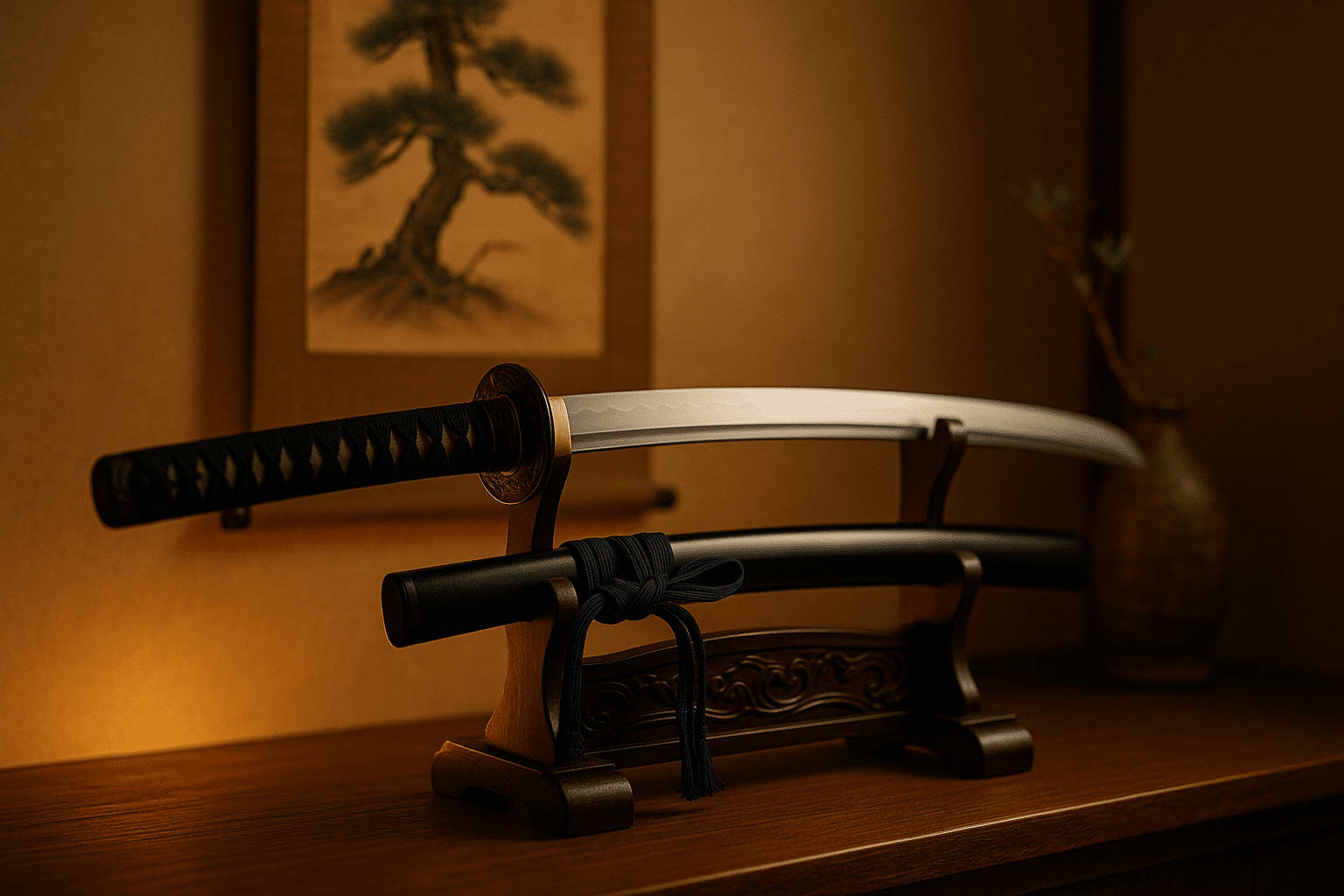Introduction: Honor in the Display
The katana is more than a weapon. It is a symbol—of courage, of craftsmanship, of discipline. Each line of its blade tells a story, honed through fire, folded in silence, shaped by hands that understand patience.
To display a katana is not to decorate. It is to honor the spirit within. The steel carries a legacy. The curve, the gleam, the edge—all demand respect.
Where and how it rests speaks volumes. The display becomes a silent bow, a quiet acknowledgement of the blade’s past and the warrior’s path.
This is not about showing off. It’s about showing reverence.
Choosing the Right Space
Select a space that feels calm and uncluttered. A katana deserves presence, not distraction.
Avoid high-traffic areas. This protects the blade and ensures it’s not bumped or mishandled.
Look for a clean, neutral backdrop. White or natural wood walls allow the katana’s form to stand out.
Keep the location above eye level but within natural line of sight. This shows respect and discourages casual handling.
Stay away from heat sources, humidity, and direct sunlight. These can damage the blade over time.
Allow for negative space around the katana. A single, purposeful display feels more powerful than many objects crowded together.
If possible, choose a space with natural light during the day and soft lighting at night. Shadows and light can subtly emphasize the blade’s elegance.
Be intentional. The right space honors both the sword’s spirit and your home’s harmony.
Mounting Options: Vertical, Horizontal, and Freestanding
There are three main ways to mount a display: vertical, horizontal, and freestanding. Each has its purpose. Each makes a statement.
Vertical Mounting
Also called portrait orientation. It draws the eye upward—clean and lean. Ideal where height is more available than width. Vertical mounting requires secure wall anchoring and careful arrangement to highlight the blade’s lines.
Horizontal Mounting
The standard for most traditional and modern environments. It matches our natural field of vision, making it perfect for appreciating the full profile of the blade. Horizontal mounting needs sturdy support across the length and should be positioned at an optimal height for viewing.
Freestanding
Self-supported and flexible, freestanding displays suit temporary setups or rooms with limited wall space. Easy to move or reconfigure, these stands must be stable and well-balanced. The freestanding option can bring the katana closer into a room’s atmosphere, inviting careful observation.
Choose with intention. Let the space, the context, and your relationship with the blade guide your display method. Form follows function—and reverence.
Materials and Aesthetics
Choose materials that reflect the katana’s spirit. Wood is a natural choice—walnut, cherry, or hinoki bring warmth and quiet strength. Avoid plastics or glossy finishes, as they may distract from the blade’s presence.
A simple wall mount or freestanding rack, crafted with care, honors tradition. Look for clean lines and minimal ornamentation, allowing the sword to speak for itself.
Match materials with your interior. A minimalist room may suit blackened steel brackets or dark woods, while rustic settings pair well with lighter grains and natural textures. Always seek harmony between the display and its surroundings.
Consider the backdrop. A neutral wall—white, stone, or raw wood—draws attention to the katana. Avoid bold colors or heavy patterns that compete with the blade’s elegance.
A well-chosen fabric mat or shikibuton beneath a tabletop mount adds dignity. Opt for subdued tones like indigo, beige, or charcoal.
Every element should serve the sword. Let simplicity and respect guide your choices.
Safety First: Securing Blade and Space
Begin by choosing a secure location—stable, dry, and out of direct sunlight. Avoid areas with high humidity or fluctuating temperatures that could promote rust or warping.
Mount your sword with purpose. Wall mounts and stands should hold the blade firmly, with minimal contact, and the blade should rest edge-up to prevent dulling over time.
Use proper materials. Choose hardwood stands, lacquered or padded, for both safety and respect. Avoid soft woods or metal hooks that could scratch or wear the blade’s surface.
Respect distance. Display your sword away from walkways, furniture, and curious hands. Security is an integral part of honoring the blade.
Keep the blade sheathed when not in use. If displayed unsheathed, ensure it is oiled and inspected regularly. Even fingerprints and dust can damage steel over time.
Above all, recognize the katana as heritage, not décor. Secure it with the same seriousness it was forged to endure.
Respecting the Blade: Cultural and Personal Significance
The katana is more than a weapon. It is a mirror of discipline, a symbol of the samurai’s code, and a legacy passed through generations.
Historically, the katana was forged with deep intention. Every curve, every fold of steel, carries profound meaning—loyalty, honor, restraint—embodying centuries of martial tradition.
Culturally, the katana reflects an entire way of life in Japan. It is surrounded by rituals of respect, from the craftsman’s mindful hammering to the warrior’s deliberate grip.
For the modern owner, the katana is undeniably personal. It requires careful maintenance and, perhaps more importantly, invites reflection. Drawing the blade is about clarity and resolve, not aggression—about understanding the bravest path is often restraint.
In a world full of distraction, the katana offers quiet strength. It teaches patience and calls for presence in every moment.
To respect the blade is to honor the journey—both the one it has traveled and the one it inspires within you.
Conclusion: Display as a Practice
Displaying a katana is more than decoration. It is a gesture of respect—for the blade, the tradition, and the path it represents.
Treat your display as an ongoing practice. Keep the space clean. Dust the stand. Adjust the angle. Observe how the blade catches light at different times. These small acts are meaningful.
Let the sword sit in quiet readiness. Its presence should inspire stillness and balance, not distraction or ego.
Approach the display with intention—again and again. In doing so, you honor not just the katana, but also the discipline and presence within yourself.





